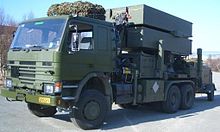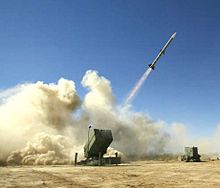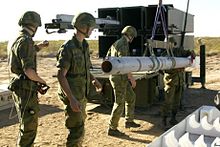- NASAMS
-
Norwegian Advanced Surface to Air Missile System 
NASAMS launcherType Surface-to-air missile system Place of origin Norway Service history In service 1998– Used by Norway, Spain, Netherlands, Finland, Chile, United States Production history Designer Kongsberg Defence & Aerospace and Raytheon Manufacturer Kongsberg Defence & Aerospace NASAMS (Norwegian Advanced Surface to Air Missile System) is a distributed and networked medium to long range air-defence system. NASAMS was the first surface-based application for the AIM-120 AMRAAM (Advanced Medium Range Air-to-Air Missile) and the first surface-to-air missile system in the western world with active radar guidance. The missile itself is named SL-AMRAAM (Surfaced Launched AMRAAM).[1]
Contents
Development
The Norwegian company Kongsberg Defence & Aerospace teamed up with Raytheon and initiated the NASAMS programme as a cooperative effort for the Royal Norwegian Air Force. The state-of-the-art network-centric air defence system NASAMS was declared fully operational capable in 1998 but had an initial operational capability as early as in 1994/95.
Until the late 1990s the RNoAF ground based air defence solution, also known as the Norwegian Solution (NORSOL), consisted of three different weapon systems; the 40mm Bofors L70 gun (controlled by the Oerlikon Contraves FCS2000 monopulse doppler tracking radar), the laser beam riding RBS 70 MANPADS system and the NASAMS. All three systems were integrated through the ARCS via field wires and radio. The ARCS maintained connection to higher echelons and ensured protection of friendly aircraft while preventing over- and underkill for all subordinate weapon systems. NASAMS capabilities[2] are enhanced by the system's networked and distributed nature.
The RNoAF together with KDA is currently running a mid-life update of the NASAMS, called NASAMS II, and the upgraded version was first handed over to RNoAF in mid 2006. The major difference the two versions will be the use of Link 16 on NASAMS II as well as a better ground radar. Full operational capability (FOC) was expected for 2007.
Users
NASAMS has been exported to Spain, Finland, and the Netherlands. The government of Chile has also ordered NASAMS. [3] [4][5]
Description
The system integrates US-built AN/MPQ-64 Sentinel 3D radars and AIM-120 AMRAAM missiles with an indigenously developed BMC4I system called FDC, short for Fire Distribution Center. The FDC connected to a TPQ-36A radar forms an "Acquisition Radar and Control System" (ARCS). The missile has a range of up to 25 km.
White House defense
In 2006 the Norwegian magazine Økonomisk Rapport (Economic Report) revealed that several NASAMS were used to guard air space over Washington, D.C. during the 2005 presidential inauguration.[6] According to the report, the same NASAMS units have since been used to protect air space around the White House. The magazine received access to the deal which mentioned specifically that the equipment be used for protection of the President in Washington. Director Tore Sannes of Kongsberg Defence & Aerospace refused to comment, other than acknowledging that they had made a weapon systems deal with U.S. military contractor Raytheon and the United States Air Force.
Although Økonomisk Rapport claimed to have revealed this in March 2006, the official webpages of the Royal Norwegian Air Force gave very clear hints about the event one year earlier, giving specific mention to the fact that the NASAMS had been used to protect Washington, D.C. during the recent presidential inauguration.[7]
See also
Notes
- ^ [1]
- ^ NASAMS suitability for cruise missile defence
- ^ "Rapid Fire: 2010-06-22". Defense Industry Daily. 2010. http://www.defenseindustrydaily.com/Rapid-Fire-2010-06-22-06442/. Retrieved 2010-06-25.
- ^ Air defence contract with the Netherlands
- ^ Dutch Order NASAMS-SLAMRAAM Air Defense Systems
- ^ Norwegian weapons are guarding the president (Norwegian)
- ^ The Norwegian Solution! (Norwegian)
External links
- Official Norwegian Defence Force website NASAMS page (Norwegian)
- Royal Norwegian Air Force Air and Missile Defence Team Page 1
- Royal Norwegian Air Force Air and Missile Defence Team Page 2
- Royal Norwegian Air Force Home Page
- NASAMS II (fact sheet in (Norwegian)
- Norwegian business magazine Økonomisk Rapport's report of NASAMS in use by US Air Force in Washington DC, February 16, 2006 (Norwegian)
- Norwegian newspaper Dagbladet's report of NASAMS guarding Washington DC, March 13, 2006 (Norwegian)
- Royal Norwegian Air Force reports protecting Washington DC, March 8, 2005 (Norwegian)
- Finland acquire NASAMS and radar system for 500 million eur April 28, 2009
Categories:- Surface-to-air missiles of Norway
- Weapons of Norway
Wikimedia Foundation. 2010.



